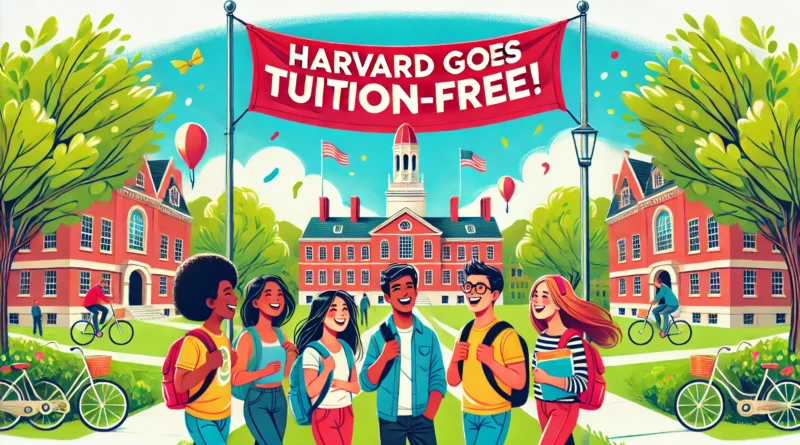Harvard Announces Tuition-Free Education for Students from Families Earning $200,000 or Less
In a groundbreaking move that could reshape access to elite higher education, Harvard University announced on Monday that starting in the 2025-26 academic year, undergraduate tuition will be free for students whose families earn $200,000 or less per year. For families with incomes of $100,000 or less, the university is taking an extra step by covering all billed expenses—including housing, meals, health insurance, and travel costs. This historic decision is expected to open Harvard’s prestigious doors to a much larger group of talented students from across the country.
Making Elite Education More Accessible
For many years, Harvard has been known for its generous financial aid program, but the new policy represents a significant expansion. Previously, free tuition was offered only to students from families earning up to $85,000 annually. With the income cap more than doubling to $200,000, roughly 86% of U.S. families are now expected to qualify for some form of financial aid at Harvard. This initiative aims to remove financial barriers for middle-income families and help create a more diverse student body.
“Putting Harvard within financial reach for more individuals widens the array of backgrounds, experiences, and perspectives that all of our students encounter, fostering their intellectual and personal growth,” said Harvard President Alan Garber in a statement. This move is not only about reducing costs; it is about making sure that a Harvard education is available to every talented student, regardless of their family’s financial situation.
A History of Evolving Financial Aid
Harvard’s commitment to affordable education is not new. In 2004, the university launched the Harvard Financial Aid Initiative to cover tuition and living expenses for students from families earning as little as $40,000 a year. Over the years, this threshold has gradually increased—from $40,000 in 2004 to $60,000 in 2006, and $85,000 in 2023. Now, with the income limit set at $200,000, Harvard is dramatically expanding its reach.
In addition to the free tuition, students from families earning $100,000 or less will receive extra support in the form of a $2,000 start-up grant during their first year and another $2,000 launch grant in their junior year. These grants are designed to help students cover costs that may arise as they adjust to college life and prepare for the next phase of their education.
The Impact on Students and Families
For many students, the rising costs of college have been a major hurdle. The average annual tuition at Harvard is around $56,550, but when you add housing, meals, and other expenses, the total can easily exceed $80,000 per year. For families making $200,000 or less, these numbers can be overwhelming. Harvard’s decision means that a high-quality education at one of the world’s most respected universities will no longer be out of reach for these families.
This new policy is expected to have a significant impact on the diversity of the student body. By lowering financial barriers, Harvard is inviting students from a wider range of economic backgrounds. Many experts believe that a more diverse classroom will lead to richer discussions, innovative ideas, and a broader perspective on global issues. With students coming from different parts of the country—and even different parts of the world—Harvard’s campus is likely to become even more vibrant and dynamic.
A Response to Changing Times
The decision to expand financial aid comes at a time when many elite institutions are rethinking how they admit students. In recent years, debates over affirmative action and diversity in higher education have been at the forefront of national discussions. Some of these debates intensified after the Supreme Court rejected certain affirmative action policies. Harvard’s new policy can be seen as part of a broader effort to maintain diversity on campus by ensuring that talented students are not kept out simply because of their financial background.
Other top universities, such as MIT, the University of Pennsylvania, and Caltech, have already taken similar steps by raising their income thresholds for free tuition. Harvard’s announcement is being closely watched by educators and policymakers alike, as it may set a new standard for how universities across the country approach financial aid and diversity.
How the Program Will Work
Starting with the 2025-26 academic year, Harvard will assess each student’s eligibility for the new financial aid program during the admissions process. Families that earn $200,000 or less will receive full tuition coverage, while those earning $100,000 or less will have their additional costs covered as well. For families with incomes above these thresholds, Harvard will continue to offer need-based financial aid tailored to individual circumstances. This personalized approach means that each student’s financial situation is taken into account, ensuring that every admitted student has the opportunity to succeed without the burden of overwhelming debt.
Harvard’s financial aid office will work closely with students and their families to guide them through the process and help them understand the full scope of the support available. The aim is to make the application process as simple and transparent as possible, so that no eligible student is left behind due to bureaucratic hurdles.
What Experts and Students Are Saying
The reaction to Harvard’s announcement has been overwhelmingly positive. Education experts point out that this initiative could be a game-changer for many students. By removing the financial barriers that have long prevented capable students from pursuing higher education, Harvard is setting an example for other institutions.
Many current Harvard students and alumni have expressed pride in the university’s commitment to diversity and inclusion. “This policy shows that Harvard is serious about its mission to educate the best and brightest, regardless of where they come from,” said one current student. “It’s exciting to think that more students like me will have the opportunity to experience everything this university has to offer.”
Parents, too, have welcomed the change. For many, the cost of college has been a source of constant worry. With tuition-free education now on the horizon for a significant portion of families, the stress of balancing a tight budget with the desire to provide a top-tier education for their children may finally ease.
Looking Ahead
While Harvard’s decision is undoubtedly a major step forward, it also raises important questions about the future of higher education. Critics of the new policy worry about the long-term financial implications for the university. However, Harvard’s substantial endowment—worth over $50 billion—provides a financial cushion that many other institutions do not have. The university’s commitment to investing in its students has historically been a key part of its identity, and this new policy is simply an extension of that legacy.
As other universities consider similar moves, it is likely that the landscape of higher education will change in the coming years. More schools may adopt policies that reduce or eliminate tuition costs for middle-income families, ultimately making elite education more accessible across the board. This trend could lead to a future where the best universities are open to all, regardless of financial background.
Conclusion
Harvard University’s decision to offer tuition-free education for students from families earning $200,000 or less marks a significant milestone in the ongoing effort to make higher education accessible to all. By expanding its financial aid program, Harvard is not only reducing the financial burden on students and their families but also promoting a more diverse and inclusive learning environment. As the policy takes effect in the 2025-26 academic year, the university hopes to inspire other institutions to follow suit, ensuring that talented students from every background have the opportunity to pursue their dreams.
In a time when the cost of education continues to rise, Harvard’s bold step serves as a reminder that knowledge should not be a privilege reserved for the wealthy. Instead, it should be an opportunity available to everyone—a chance to build a better future, one student at a time.



